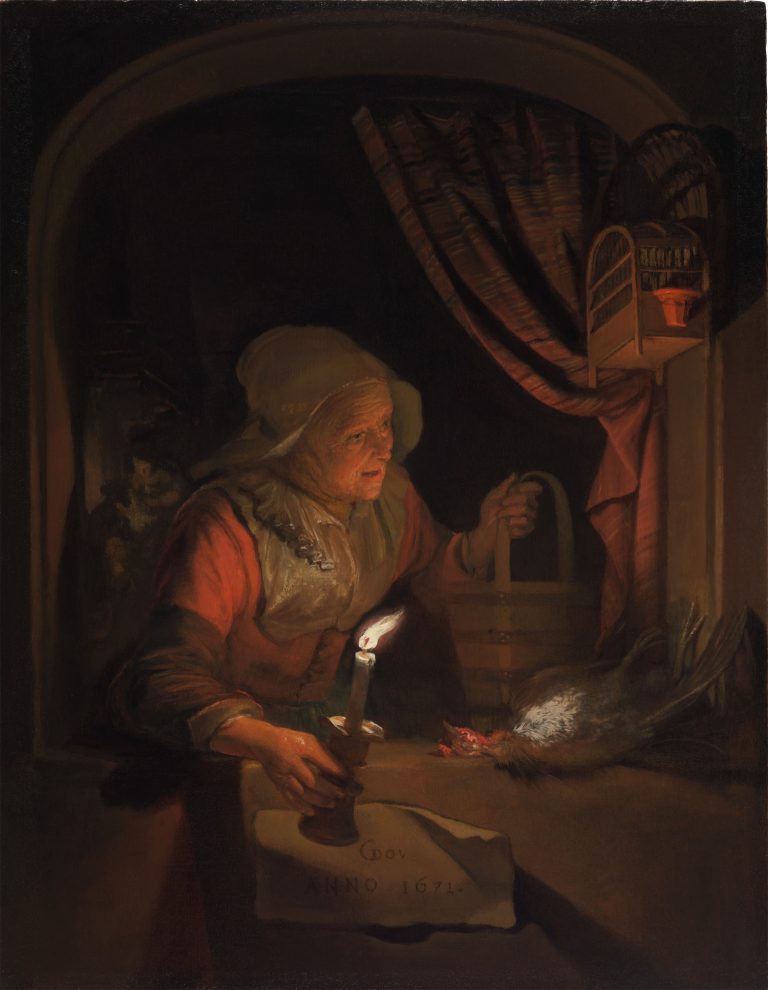In the early nineteenth-century, John Smith observed that Gerrit Dou’s Old Woman at a Window with a Candle, despite its powerful effect, did not exhibit the usual meticulous finish associated with the artist.1 Indeed, Dou executed this scene with loosely brushed strokes in the highlighted areas and thinly applied paints in the shadows. The freshness of this technique allowed him to capture a spontaneous moment of visual and emotional suspense. The old woman, seemingly stirred by a noise from outside, leans out of the arched, stone window opening into the darkness. Illuminated by the flickering flame of the candle, she looks to the side, her lips slightly parted as though she were calling out into the night.
As in some of Dou’s other niche scenes (three of which are in the present collection: Cat Crouching on the Ledge of an Artist’s Atelier, (GD-108); Herring Seller and Boy, (GD-106); and Young Woman in a Niche with a Parrot and Cage, (GD-105), the artist used the arched window frame both as a repoussoir device and as a means to concentrate our focus on the pictorial narrative. Here, Dou positioned the woman so that her candlestick and its flame provide the painting’s visual focus, similar to his Young Woman with a Lighted Candle at a Window from ca. 1658–65 (fig 1). They also emphatically break the picture plane as the woman reaches across the threshold of the window to extend the path of her light. As the candlelight flutters in the open air, it casts radiating shadows along the inside of the niche while illuminating Dou’s name and the painting’s date of 1671 inscribed on the sheet of paper attached to the building’s stone exterior.2 Simultaneously, the flame casts a reddish glow on the old woman’s ruddy face, her simple red and white chemise and bodice, the empty birdcage in the upper right, and the limp body of a dead hen lying on the windowsill.3
Dou often included subsidiary figures in the backgrounds of his paintings, either as narrative commentaries or enhancements to his primary subject. Here, sketchily blocked out in the dark interior are a man and a woman who sit before a warming fire. A similar juxtaposition of foreground and background figures is seen in Dou’s earlier nocturnal scene The Wine Cellar from ca. 1660 (fig 2). Here, as Ronni Baer has suggested, the two figures in the foreground represent “young love” while the solitary figure in the background references winter and old age.4 The present work probably represents an inversion of this idea, with the primary subject portraying a solitary woman as the embodiment of old age in counterpoint to the warmth of human companionship shared by the couple in the background. The empty wooden pail and the unoccupied birdcage symbolize life that has expired, as does the dead hen, which signifies that the old woman herself may be nearing her end.5
Although the position of the candlestick has particular iconographic and compositional significance, Dou seems to have arrived at the final arrangement well into the paint process. Initially, he intended the old woman to hold an oil lamp on the window ledge, as can be seen in a photograph taken during restoration (fig 3). A similar oil lamp, with a flame emitting from its side, is found in Dou’s Old Woman with Two Young Children, dated ca. 1655–65, in the Museum of Fine Arts, Boston (fig 4). Dou subsequently replaced the oil lamp with the basket she now holds.6 Intriguingly, the way the woman’s face is lit from the front reflects the original position of the oil lamp, while the broader network of highlights and shadows on the niche derive from the candlelight. The character of these varied light sources indicate that Dou made this compositional modification at a relatively late stage in the painting’s execution.
Another change in the composition was in the position of the birdcage. While its final location is comparable to that found in numerous other paintings by the artist, infrared photographs indicate that Dou originally positioned it hanging lower down on the frame, to the right of the basket.7 This original location would have placed it along the old woman’s direct line of sight, thus making it the focus of her gaze, possibly as a reference to departed innocence or youth.8 This change seems to have coincided with the introduction of the dead hen lying on the ledge, indicating a deepening of the reference to senescence and the culmination of life. Other changes in the composition are evident at the lower right corner. Dou must have originally intended to depict a small flowerpot just below the ledge, as pentimenti of its shape can be seen just below the dead chicken in the infrared image. A similar flowerpot is found in a comparable scene of an old woman at a niche from ca. 1660, now in the Kunsthistorisches Museum, Gemäldegalerie, Vienna.9
The earliest provenance of Old Woman at a Window with a Candle is from the mid-eighteenth century, when the work formed part of the notable Parisian collections of Nicolas de Montribloud and Claude Tolozan. By 1802, when the painting was with the London art dealer Michael Bryan, it was announced as having been part of the Citoyen Robit Collection, an association that seems to have been made in error.10 During the first three decades of the nineteenth century, the painting was actively traded at auction in London at least ten times and was owned by at least four private collectors between 1809 and 1828, a period that attests to the English market’s keen interest in this powerfully atmospheric work.
